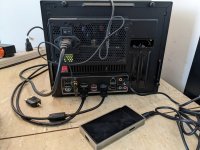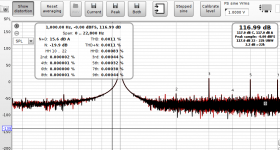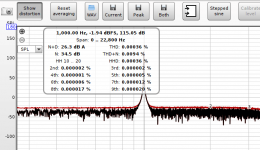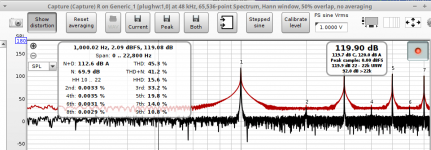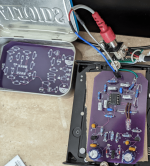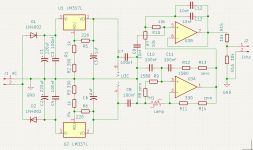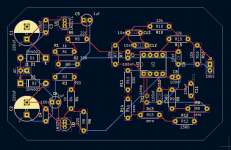The sine oscillator in the LM4562 document is only a model. Can it be made into a stable 1khz circuit without using the lamp which is supposed to prevent distortion. I have been reading about various solutions. They seem to be rather delicate.

Long story .. https://sound-au.com/articles/sinewave.htm#s2
Long story .. https://sound-au.com/articles/sinewave.htm#s2
Yes, some are here. It will be difficult to have very low distortion, though.
https://www.ti.com/sc/docs/apps/msp/journal/aug2000/aug_07.pdf
https://www.ti.com/sc/docs/apps/msp/journal/aug2000/aug_07.pdf
Last edited:
Thanks for the link. The author seems to prefer the Bubba oscillator. I found a similiar link with distortion measurements. (between 0.4% and 1% using unipolar ICs).Yes, some are here. It will be difficult to have very low distortion, though.
https://www.ti.com/sc/docs/apps/msp/journal/aug2000/aug_07.pdf
https://www.hscott.net/bubba.pdf
Concluding Remarks The ability to create stable oscillations from only a DC source is useful in many applications, especially when cost is a major design factor. The Bubba oscillator can replace crystals and resonators that are costly and difficult to find for frequencies below 30 kHz. It also has the advantage of adjustability. By simply changing the resistance at certain points in the circuit, the frequency can be changed. Because of its versatility, the Bubba oscillator is perfect for small, cheap radios like those used in covert listening scenarios.
...
There are three diyAudio members with the prefix Bubba but I did not find a practical Bubba oscillator.
There is probably not much of a market for Bubba electronics. 🙂
Last edited:
What's your application? If distortion around 1% is ok, just do the lamp.
The lamp will last a long time, since it's never lit up much if at all.
It can even be soldered in, no socket.
Though the Bubba can be made with one quad op amp. Try both.
The lamp will last a long time, since it's never lit up much if at all.
It can even be soldered in, no socket.
Though the Bubba can be made with one quad op amp. Try both.
None of mine ever failed. One was 50 years old, and abused, and worked fine.The lamp will last a long time,
A simple lamp is not dead-steady output as frequency is changed (unless tuning parts are perfect). But fubar3 is asking for just 1kHz? All the "better" plans are FAR more complicated, IMHO.
I've heard of the lamp in an old HP oscillator failing, but that was an actual large light bulb,
not a miniature type. My old Heathkit never failed.
not a miniature type. My old Heathkit never failed.
Bill Hewlett build HP around that simple oscillator. It does work and getting low distortion is possible. The lamps run at a fraction of their rating and should last as long as the device would be useful. Finding an optimum lamp is important. Its actually more linear than any of the other AGC solutions but its response is slow so stability in output takes a while.
You can sink into oscillator fetishes and distortion nuttery here: https://www.diyaudio.com/community/threads/low-distortion-audio-range-oscillator.205304/post-2878236 Its only 496 pages. . .
For many tests a sine generator app on a phone will get a clean low distortion frequency accurate source.
You can sink into oscillator fetishes and distortion nuttery here: https://www.diyaudio.com/community/threads/low-distortion-audio-range-oscillator.205304/post-2878236 Its only 496 pages. . .
For many tests a sine generator app on a phone will get a clean low distortion frequency accurate source.
I was curious about the Whammy which has opamp options. It seems like the opamps I tried were equivalent for frequency response. More sophisticated tests are needed.What's your application? If distortion around 1% is ok, just do the lamp.....
https://www.diyaudio.com/community/threads/tools-for-opamp-rolling.388821/#post-7096227
I am experimenting with REW but it requires an expensive Focuswrite to send audio samples over USB. I don't want to buy expensive gear just to satisfy idle curiousity. I just want to DIY.
Thanks, I don't have a laptop I have a mini-itx cube chassis with AB350 mobo having Radeon 3 integrated graphics. There are no gaming components, i just like the compact format.
https://www.diyaudio.com/community/...urements-with-rew.338511/page-69#post-7087822
The mobo has a Realtek multi-channel ALC1220 codec which is said to have a 120db SNR. I am skeptical about real-world usage. XRK971 has found these devices have too much noise. I attach cards.txt which has a list of channels and functions. It is interesting that if one has an external USB DAC, the codec is responsible for streaming so it is essential and cannot be fully bypassed.
I attempted some REW measures. I find it too complicated. It should be more modular with modes for specific purposes that don't activate multiple option panels. So I muddle and hope for REW-lite.
https://www.diyaudio.com/community/...urements-with-rew.338511/page-69#post-7087822
The mobo has a Realtek multi-channel ALC1220 codec which is said to have a 120db SNR. I am skeptical about real-world usage. XRK971 has found these devices have too much noise. I attach cards.txt which has a list of channels and functions. It is interesting that if one has an external USB DAC, the codec is responsible for streaming so it is essential and cannot be fully bypassed.
I attempted some REW measures. I find it too complicated. It should be more modular with modes for specific purposes that don't activate multiple option panels. So I muddle and hope for REW-lite.
- shot 2 .. using REW generator which has dominant odd harmonics
- shot 3 .. FFT of Audacity WAV file (which REW calls MDAT)
- shot 4 .. same WAV send from FIIO M7 to the mobo line input.
Attachments
The thread asks "Can it be made practical" and yes, this has been done.
Mr Heuvel has an interesting investigation into the Wein network lamp oscillator. His lamp choice is better than the old #327.


This makes an interesting DIY opportunity.. not too many components but some subtle challenges.
I usually solder parts onto a grid board. This time, for a change, I am tinkering with KiCad to design a PCB.
- https://www.analog.com/media/en/technical-documentation/data-sheets/lt1007-lt1037.pdf ..has lamp oscillator on page 1
- https://www.elektormagazine.com/index.php/files/attachment/326 .. project 53 by Hein van den Heuvel
Mr Heuvel has an interesting investigation into the Wein network lamp oscillator. His lamp choice is better than the old #327.
This makes an interesting DIY opportunity.. not too many components but some subtle challenges.
I usually solder parts onto a grid board. This time, for a change, I am tinkering with KiCad to design a PCB.
First there was a minimalist green PCB (KiCad) that was promising. It used half 4562 and 78/79 L15 regulators. Now there is a larger purple PCB that adds a Butterworth filter to reduce the 3rd harmonic. This version operates at +-9.1vdc and could be modified to use batteries. I cut the PCB to fit an Altoids tin just for grins.
Many of the resistors are elevated for ease of replacement and for convenience of probe clipping. There is an option to combine 2 resistors for a single values in the oscillator circuit. Otherwise 1 resistor can span the footprint of 2 resistors. The 317-337 are adjusted with 2 resistors .. 1k+390 = 1390 which gives 9.1vdc.
The PCB can work with 9.5vac, 12vac, or 16vac. The choice of regulators, fixed or adjustable, does not matter. However, when powered for +-15vdc, the 4562 and regulators feel hot if touched for more than a few seconds. There is no need to run hot since it would only require more output attenuation .. no advantage.
I tested the oscillator with REW. The U3b Butterworth filter is optional but 3rd harmonic is 20db higher without it. I might be suitable for casual use. One can always buy a slightly better oscillator if there is no interest in DIY.
Many of the resistors are elevated for ease of replacement and for convenience of probe clipping. There is an option to combine 2 resistors for a single values in the oscillator circuit. Otherwise 1 resistor can span the footprint of 2 resistors. The 317-337 are adjusted with 2 resistors .. 1k+390 = 1390 which gives 9.1vdc.
The PCB can work with 9.5vac, 12vac, or 16vac. The choice of regulators, fixed or adjustable, does not matter. However, when powered for +-15vdc, the 4562 and regulators feel hot if touched for more than a few seconds. There is no need to run hot since it would only require more output attenuation .. no advantage.
I tested the oscillator with REW. The U3b Butterworth filter is optional but 3rd harmonic is 20db higher without it. I might be suitable for casual use. One can always buy a slightly better oscillator if there is no interest in DIY.
Attachments
- Home
- Design & Build
- Equipment & Tools
- Sine Oscillator with 4562 and lamp. Can it be made practical?
